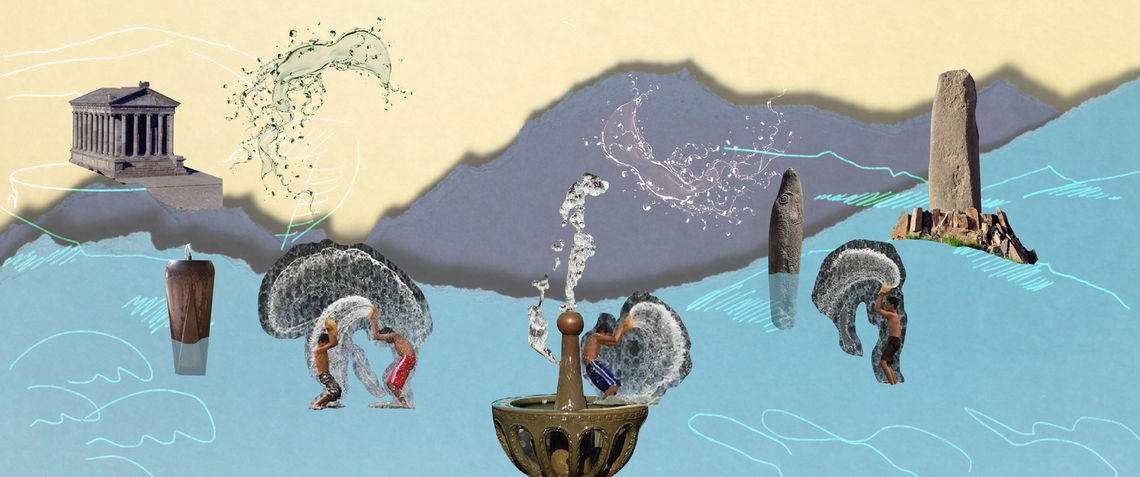
Illustration by Armine Shahbazyan.
Traditions and rituals are sometimes perceived as remnants of the past, with little real connection to our present, contemporary lives. However, there are several water-related rituals and artifacts in Armenian culture dating back centuries that might convince us otherwise. They include the famous holiday of Vardavar, which has come a long way from its pagan beginnings, when the goddess of love and fertility, Astghik, would spray rosewater to spread love. It has turned into a colossal annual water festival entertaining locals and tourists alike.
There are mythical stories of gods and goddesses like Tsovinar (meaning, daughter of the seas), who was considered the goddess of water and gave birth to humanity. Goddesses Astghik and Anahit are also said to have been gifted with water powers.[1]
Armenians have borrowed or created a variety of water-related rituals, some of which are still practiced today. These include gathering water from seven different sources to heal a patient or throwing water after travelers to wish them luck and safety.
These are merely small glimpses of water’s significance in Armenian culture, which according to archaeologist Boris Gasparyan from the Institute of Archaeology and Ethnography (IAE) has always been considered miraculous and an object of worship during different stages of Armenian history.
Prehistoric vishapakars, or “dragon-stones,” are a prominent example. They represent the institutionalization of water worship, says Arsen Bobokhyan, Deputy Director of IAE’s Department of the Early Archaeology of Armenia and vishapakar specialist. Vishapakars, sometimes simply referred to as “vishaps” (dragons), are native only to the Armenian Highlands. They are four to five-meter long stelae found near water springs—typically 2,000-3,000 meters above sea level․ According to Naira Harutyunyan, they are also closely related to the irrigation activities of the ancient Urartians. The dragon-like images carved on the Bronze-Age[2] statues are tied to folk tales about giant monsters that lived in the mountains in and around Lake Van.


While the most distinctive feature of vishapakars is its round shape, three types exist: bull-shaped (tslakerp), fish-shaped (tsknakerp) and a hybrid of a bull and a fish (tsla-tsknakerp). According to Bobokhyan, there are around 120 vishapakars in different parts of Armenia, the largest concentration of which, 12, is found near Mount Aragats.
Worshipping or attaching great importance to water does not end with vishapakars. Bobokhyan explains that vishapakars belong to a group of cultural representations that have traveled from one period of time to another.
Although different in their design and the locations in which they are found, Bobokhyan considers khachkars to be a transformation of the vishapakar tradition that took place during the Medieval Ages.
Khachkars (or cross-stones), which are multi-motif cross-bearing monuments, are very well-known representations of Medieval Armenian Christian art that continue to be a part of modern culture for Armenians around the world.[3]
Similar to vishapakars, khachkars also represent a phenomenon that only exists in the Armenian Highlands, a discovery first made by one of the earliest researchers of vishapakars, historian and scholar of the Caucasus, Nicholas Marr. Some of them were even erected next to water sources. Just like the Armenian Apostolic Church adopted the pagan Vardavar holiday into Christianity as the Feast of the Transfiguration, Gasparyan believes it is likely that the Church played a role in modeling khachkars after vishapakars; some are in fact carved directly into them.
Next in the sequence of water-related monuments come the tsaytaghbyurs (water fountains), more commonly called “pulpulaks.” They are less than one-meter tall fountains with running water that can be found throughout cities and towns across Armenia.
Even though their proliferation occurred during the Soviet years, according to Bobokhyan, tsaytaghbyurs have existed since the Middle Ages, with some also resembling dragons like vishapakars. With the atheist ideological pressure of the Soviet Union, it became more common to build tsaytaghbyurs instead of khachkars. Some were erected to celebrate a major event. Others built them as memorials to loved ones that had passed away.
Bobokhyan explains that tsaytaghbyurs exemplify a communal experience. Especially in villages, it is common to set up benches around water fountains. And this goes back to vishapakars and how prehistoric humans similarly created communities around water. For Bobokhyan, the reason for this is simple, as complex as it may seem.

The understanding of water is archetypal, says Bobokhyan. A human’s consciousness experiences the same reflex when they hear the word “water.” That which was once manifested as a vishapakar, became a khachkar at another point, and a tsaytaghbyur later on.
Water, an integral component of those rituals and traditions, “has remained with us, is part of us, in ways more than people regularly perceive,” says Bobokhyan.
--------------
[1] Sarukhan, H., Grigorian, V., Manoukyan, K., Sahakyan, A., Hovhannisyan, A. & Simonian, H. (2013). Six Armenian Poets (R. Davoyan, Ed.). Arc Publications.
[2] There is a possibility that they might be older, possibly dating to the 5th millennium BC.
[3] Hourihane, C. P. (Ed.). (2012). The Grove Encyclopedia of Medieval Art and Architecture. Oxford University Press.
Water - Magazine Issue N9

Global Water Scarcity and Its Implications for Armenia
By Paruyr Abrahamyan
In this comprehensive piece on water security, Paruyr Abrahamyan provides an in-depth overview of global water scarcity, how this will potentially compound the already-complex problems facing the South Caucasus and makes a number of recommendations.
The Ups and Downs of Lake Sevan
By Hovhannes Nazaretyan
Lake Sevan is the largest freshwater and alpine lake in the entire South Caucasus. The lake’s artificial outflow which commenced in the early 1930s during the Soviet period resulted in dramatic changes in its water level and continued ecological problems.





